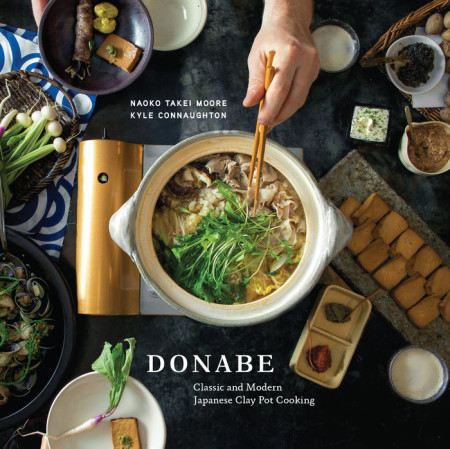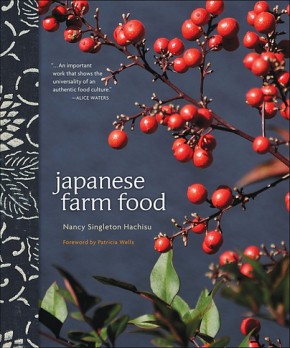DonabeClassic and Modern Japanese Clay Pot Cooking

A beautiful and lavishly photographed cookbook focused on authentic Japanese clay-pot cooking, showcasing beloved recipes and updates on classics, with background on the origins and history of donabe.
Japanese clay pot (donabe) cooking has been refined over centuries into a versatile and simple method for preparing both dramatic and comforting one-pot meals. In Donabe, Tokyo native and cooking school instructor Naoko Takei Moore and chef Kyle Connaughton offer inspiring Japanese home-style recipes such as Sizzling Tofu and Mushrooms in Miso Sauce and Dashi-Rich Shabu-Shabu, as well as California-inspired dishes including Steam-Fried Black Cod with Crisp Potatoes, Leeks, and Walnut-Nori Pesto or Smoked Duck Breast with Creamy Wasabi–Green Onion Dipping Sauce. All are rich in flavor, simple to prepare, and perfect for a communal dining experience with family and friends. Donabe also features recipes from luminary chefs such as David Kinch, Namae Shinobu, and Cortney Burns and Nick Balla, all of whom use donabe in their own kitchens. Collectible, beautiful, and functional, donabe can easily be an essential part of your cooking repertoire.
“Donabe represents so much more than simply cooking food. It’s the creation of an experience that is completely unique, one that brings together the people you love in a moment that not only will satisfy your appetite, but nourishes your soul. This book will feed your spirit for years to come.”
-Morgan Spurlock, Filmmaker, Foodie & Donabe Enthusias
Crab Rice with Charred Green Onion, Tatsoi, and Sesame
Sake-Lover’s Ginger Pork Sukiyaki
Salmon and Hijiki Rice (SakeHijiki Gohan)
Kombu and Bonito Dashi

Crab Rice with Charred Green Onion, Tatsoi, and Sesame
Serves 4 to 6 as part of a multicourse meal
With so many possible variations, it’s difficult to choose which rice recipes to share. This is a satisfying and relatively easy one that makes a complete meal with only a small amount of crabmeat. I like to make this dish on the Sonoma Coast of California, using local Dungeness crabs when they are in season; however, most varieties of crab will work just fine.
Buying whole crabs will yield you the shells and all the meaty flavors that come with them. The shells can be used to make the crab dashi, which can be used in place of water when cooking the rice to give a deeper, more complex umami flavor. The dashi instructions here make much more than the recipe requires, so you can enjoy the rest by trying the Hokkaido-Style Seafood-Miso-Kimchi Hot Pot or by serving it as a clear soup to accompany this dish. To make a soup from it, combine the dashi with just a bit of reserved crabmeat and a few of the tatsoi leaves, and add a sprinkle of salt, soy sauce, or shiro shoyu (white soy sauce).
Once you feel comfortable with he techniques in this dish, you can easily customize it to suit your tastes and the seafood you have on hand. We enjoy adding different typed of kimchi to this dish, as well as ginger, braised kombu, gingko nuts, mushrooms, and a variety of vegetables. – Kyle
Equipment: One double-lid donabe rice cooker (3-rice-cup size)
3 rice cups (2 1⁄4 cups/540 ml) short-grain white rice, rinsed
2 1⁄4 cups (540 ml) water or leftover Crab Dashi (recipe follows)
2 bunches green onions
1⁄4 cup (60 ml) grapeseed or canola oil
1 tablespoon toasted sesame oil
1⁄4 cup (60 ml) mirin
1⁄3 cup shiro shoyu (white soy sauce) or usukuchi shoyu (light-colored soy sauce)
4 ounces (120 g) baby tatsoi leaves (about 2 cups loosely packed; can substitute baby spinach leaves, turnip greens, mizuna, or pea tendrils)
Crabmeat reserved from the Crab Dashi, or 1 pound (450 g) lump crabmeat
1 cup (240 ml) Crab Dashi (recipe follows) or Kombu and Bonito Dashi
1-2 tablespoons toasted white sesame seeds
Sea salt or soy sauce (optional)
Ichimi togarashi (Japanese ground chiles), for garnish
In the donabe, combine the rice with the water. (If you have made the crab dashi and have at least 3 1⁄4 cups, you can substitute 2 1⁄4 cups for the water here. Just make sure you have 1 cup left over to use later.) Let the rice soak for 20 minutes. Cover with both lids and cook over medium-high heat for 13 to 15 minutes. Turn off the heat and let it rest for 20 minutes.
Meanwhile, working in batches, lay the green onions in a large dry sauté pan and char over medium-high heat, turning regularly, for 2 to 3 minutes. The green onions will begin to steam in their own moisture and char on the outside. Remove from the sauté pan and lay the green onions all facing the same direction on a cutting board. Trim the root end and a few inches of the green tops and discard. Slice the green onions into 1⁄4-inch (6 mm) rounds and reserve.
Wipe out the sauté pan and heat the grapeseed oil over medium heat. Add the charred green onions and sauté for 1 minute, stirring frequently. Add the sesame oil and the mirin and scrape the pan to deglaze. Allow the alcohol to evaporate (1 to 2 minutes) and remove the pan from the heat. As the pan is cooling, swirl in the shiro shoyu. Set the green onions aside.
Prepare a bowl of ice water and set aside. Bring a medium to large pot of salted water to a boil. Blanch the tatsoi leaves for 10 seconds and transfer the tatsoi immediately to the ice water. Once chilled, remove the leaves from the ice water, drain, and reserve.
To finish the dish, fold the crabmeat into the rice (reserving some nice lump pieces for garnish), 1 cup (240 ml) of the crab dashi(or other dashi), the charred green onion mixture, the tatsoi leaves, and the toasted sesame seeds. Cover the rice cooker and gently heat over a medium flame for 3 to 4 minutes to heat thoroughly and perfume the rice with the crab aroma. Season with salt or additional soy sauce if desired, and garnish with the reserved lump crab pieces, additional sesame seeds, and ichimi togarashi.
Crab Dashi
Makes 7 to 8 cups
If you can’t get a whole crab, forgo making this dashiand substitute 1 pound (450 g) lump crabmeat and 1 cup Kombu and Bonito Dashi in the rice recipe.
1 whole Dungeness or stone crab
1 (4-inch/10 cm) square kombu
2 quarts (2 L) water, soft (low-mineral-content) preferred
1 ounce (30g) loosely packed katsuobushi (dried bonito flakes)
If using live crab, steam for 15 minutes, until cooked through, and then chill the whole crab before separating the meat from the shell. Chill thoroughly in an ice bath or the refrigerator. Clean the crab by separating the meat from the shells and reserve the meat. Remove any lungs, eyes, or apron using scissors, and discard. If you like a richly umami “sea flavor,” mix in any of the cooked brown sections of the crab with the meat, or keep them with the shells for a deeper-flavored stock. Reserve some of the nice lump pieces of meat for garnish on top of the final rice dish.
In a medium pot, combine the reserved shells with the kombu and cover with the water. Heat gently and maintain the low heat below a simmer for 1 hour to infuse the crab and kombu into the stock. Remove the kombu and raise the heat slightly, still just below a simmer. Add the katsuobushiand turn off the heat. Steep for 5 minutes and strain through a fine-mesh sieve. Reserve 1 cup (240 ml) of strained stock for the final rice dish. Use the remaining stock to make a clear crab soup or for cooking the rice, if desired.

Sake-Lover’s Ginger Pork Sukiyaki
Serves 4
Unlike a traditional sukiyaki, no sugar or mirin is used in this recipe. The dish tastes savory with a hint of natural sweetness from the onion. I named this dish Sake-Lover’s Ginger Pork Sukiyaki because sake drinkers in Japan typically prefer less-sweet dishes to pair with dry sake. My sake-loving friends tell me this dish makes them want to drink more sake. I like to make it with thinly sliced pork belly, but pork butt slices or even chicken thighs (cut into bite-size pieces) can work very nicely as well. – Naoko
Equipment: 1 large tagine-style donabe (12 1/2-inch-/31.5 cm-diameter skillet size)
1/4 cup (60 ml) plus 2 tablespoons sake
1 pound (450 g) thinly sliced pork belly, cut into 1 1/2-inch (4 cm) strips
1/2 cup (120 ml) Kombu and Bonito Dashi (see separate recipe)
1/4 cup (60 ml) soy sauce
1 tablespoon toasted sesame oil
1 medium yellow or sweet onion, thinly sliced
1 clove garlic, thinly sliced
1 tablespoon finely julienned peeled fresh ginger
6 medium-size shiitake mushrooms, trimmed and thinly sliced
7 ounces (200 g) shirataki noodles (konnyaku noodles), blanched and cut into 2-inch (5 cm) pieces
1 green onion, very thinly sliced on the diagonal, for garnish
Shichimi togarashi (Japanese seven-spice blend), for serving
In a bowl, splash 2 tablespoons sake over the pork and lightly toss by hand. Let it marinate for 15 to 30 minutes.
To make the sauce: Combine the dashi, remaining ¼ cup sake and soy sauce in a bowl. Set aside.
Heat the sesame oil in the donabe over medium heat; add the onion, garlic, and ginger and sauté for a couple of minutes. Add the shiitakes and sauté for an additional couple of minutes, or until the shiitakes are soft. Add the pork and continue to sauté until the meat is almost cooked through, about 3 to 4 minutes. Add the shirataki noodles and stir well.
Add the sauce into. Cover and bring to a simmer. Cook for 7 to 8 minutes, or until the sauce is reduced by one-third or so, stirring a couple of times. Turn off the heat and let it rest, covered, for 3 to 5 minutes.
Uncover at the table and garnish with the green onion. Serve in individual bowls and sprinkle with some shichimi togarashi.

Salmon and Hijiki Rice (SakeHijiki Gohan)
Serves 4 to 6 as part of a multicourse meal
Equipment: 1 double-lidded donabe rice cooker (3-rice-cup size)
I’ve been making this dish for years, and it’s also one of the most popular rice dishs in my cooking class. Because everything is cooked together in a donabe, the salmon releases more flavors as the dish is being cooked (just like making dashi), and hijiki seaweed adds a nice mineral-rich taste. The preparation starts a day before with the simple process of salt-curing the salmon overnight, but if you have access to a Japanese market, you can use already prepared lightly salted salmon (shio-jake) instead. Once you plate the rice, I like to serve this dish with a generous amount of mixed herbs on top and a good squeeze of lemon. The dish is so refreshing that you can enjoy it like a salad. – Naoko
2 1/2 rice cups (2 cups minus 2 tablespoons/450 ml) short-grain white rice, rinsed
1 2/3 cups (400 ml) Kombu and Bonito Dashi (see separate recipe)
2 tablespoons sake
2 teaspoons usukuchi shoyu (light-colored soy sauce)
2 teaspoons toasted sesame oil
1/10 ounce (3 g; about 1 tablespoon) dried hijiki seaweed, rehydrated (see Note)
7 ounces (200 g) Salt-Cured Salmon (recipe follows), cut into 2 to 3 pieces, or store-bought lightly salted salmon (shio-jake)
Mixed chopped herbs and aromatics (such as a handful of daikon sprouts; 1 green onion, white and green parts; and 1 small bunch mitsuba), tossed with a seeded and thinly sliced dried red chile or 1/2 teaspoon red pepper flakes, for serving
Lemon wedges, for serving
In the donabe, combine the rice with the dashi, sake, usukuchi shoyu, and sesame oil. Let the rice soak for 20 minutes.
Spread the rehydrated hijikiover the rice and lay the salmon on top. Cover with both lids and cook over medium-high heat for 13 to 15 minutes. Turn off the heat and let it rest undisturbed for 20 minutes.
Uncover, peel off the salmon skin (also remove the bones if using store-bought salted salmon), and gently fluff by breaking up the fish with a spatula until all the components are mixed thoroughly. Serve in individual bowls at the table. Top with some mixed chopped herbs, and squeeze lemon to enjoy.
Note: Here are the simple ways to rehydrate dried hijiki. First, soak the hijiki in an ample amount of water in a bowl for about 30 minutes. Make sure you don’t oversoak the hijiki, as it contains rich water-soluble fiber that could be lost, and the texture will become too mushy. Gently transfer the hijiki by hand into a colander, trying to leave most of the gritty stuff behind, finally, rinse thoroughly under running water and drain well.
Salt-Cured Salmon (Shio-jake)
Makes about 1 pound (450 g)
Shio-jakeis such a popular item in Japan that you can find a wide array of it at almost any local grocery store or department store year-round. It’s most typically eaten simply grilled and served with rice, and is a popular filling for onigiri(rice balls), too. Making it at home is very easy, and you can adjust the saltiness to suit your preference. The cured salmon will keep for a few days in the refrigerator, tightly wrapped in plastic wrap.
To make Japanese-style grilled salmon, slice the cured fillet into four to six pieces and cook over a stove-top grill or pan-fry until done. You can also roast the whole fillet in the oven for 8 to 10 minutes at 450°F (230°C) and serve family-style. Serve with grated daikon and lemon wedges as condiments, if you like. – Naoko
Rub the salt all over both sides of the fillet and wrap with two layers of plastic wrap.
Place the salmon on a tray and place another flat-bottomed tray on top of the fish. Place something that weighs 2 to 2.5 pounds (900 g to 1.25 kg) on the top tray. Refrigerate for at least 24 and up to 48 hours.
Remove the plastic wrap and wipe off the moisture and salt from the salmon with paper towels. Your cured salmon is ready to cook.

Kombu and Bonito Dashi
Makes about 7 cups (1.8 L)
This is a basic dashithat can be used in a wide variety of Japanese dishes. It’s commonly called awase dashi (blend dashi) or ichiban dashi (first dashi). Once you have dried kombu and bonito in your pantry, you can easily make it whenever you need it. I just love the smell of dashiin my kitchen. Freshly made dashiis perfect for a simple clear soup, allowing you to really appreciate its delicate umami taste. I even drink cold dashistraight just to charge me up in warm weather. I have included notes about different variations of dashimaking, from more elaborate (longer) versions to shortcuts. So, you can stick to a single way that fits you the best, or you can use different methods in accordance with how rich you want to make your dashi and how much time you have. You can also adjust the amount of kombu and/or katsuobushito your preference. Don’t worry too much about the measurement of the ingredients or how long to infuse especially for your everyday cooking! Just make sure to get the high quality ingredients.
Kombu and Bonito Dashi can keep for a few days in the refrigerator. For convenience, you can make a large batch to use over several days, though there is nothing better than the flavor of freshly made dashi. – Naoko
2 quarts (2 l) water, low mineral content preferred (see Note)
3 (4-inch/10 cm) square pieces kombu (about 2/3 ounce/20g)
1 ounce (30 g) katsuobushi (dried bonito flakes)
Combine the water and kombu in a donabe and let the kombu soak for 30 minutes. The kombu will reconstitute and double in size.
Set the donabe, uncovered, over medium heat. Just before the broth comes to a simmer (after about 20 to 25 minutes), remove the kombu. Then quickly turn up the heat to bring to a simmer; immediately turn off the heat. Add the katsuobushiall at once.
Wait until the katsuobushisettles in the bottom of the donabe, about 2 minutes. Strain into a bowl through a fine-mesh sieve lined with a double layer of damp cheesecloth or a thin cotton cloth. Let the dashistrain by gravity or press very gently. Do not press hard or squeeze, as doing so will add a slight fishy flavor to the dashi.
For everyday use at home, I actually strain dashidirectly through a fine-mesh strainer without lining it with a cloth. It’s less fuss! The residue will settle at the bottom, so when I need to use the very clear dashi, I just scoop gently from the top without stirring it.
When I’m really short on time and need only a small amount of dashi, here’s a good shortcut: I sometimes use on tea bag–style dashifor convenience. There are slight variations depending on the brand, but essentially, you simply infuse a dashi tea bag in simmering water for a few minutes, and it’s ready. There are many different brands of really tasty dashitea bags available in Japan, and some are imported to the United States. When choosing tea bag–style dashi, I suggest you choose a kind that includes only natural ingredients (no MSG or artificial flavors).
Enriched Dashi
My standard ratio for water to kombu and water to katsuobushiis between 100:1 and 100:1.5 by weight. In other words, for every 4 cups (1 L) of water, use 1/3 to 1/2 ounce (10 to 15 g) each of kombu and katsuobushi. For richer dashi, you can adjust the ratio to about 100:3— that is, for the same amount of water, use up to 1 ounce (30 g) each of kombu and katsuobushi. Once you familiarize yourself with the standard ratio of kombu and bonito dashi, it’s also fun to try using different ratios to taste the flavor differences. Once you become your own dashi expert, you can even adjust the ratio dish by dish to your preference. For some dishes, you might prefer an extra-rich flavor of katsuobushior a very light flavor.
Here are some other (more economical) ways to make richer (higher-umami-level) dashi, using the same amount of kombu. Use just one, or combine them:
1. Increase the soaking time of the kombu in the water to a few hours or even overnight (cold infusion). In this case, use a separate bowl for soaking and transfer to a donabe to heat when ready to make the dashi. Keep refrigerated if the room is warm or if you’re soaking overnight.
2. Once the kombu is reconstituted after soaking in water, use scissors to cut many slits into the kombu. It will infuse more of its flavor this way. Continue to soak longer or start heating to make dashi.
3. When you heat the kombu in the water to make dashi, start with medium-high heat and turn it down to very low once the water temperature reaches 140°F (60°C). Make sure the temperature stays at the same level and let the kombu infuse for 1 hour. That’s the optimal temperature for kombu to infuse its rich umami flavor (glutamate). Then remove the kombu and follow the rest of the steps.
Second Dashi
After you’ve made your dashi, what can you do with the used kombu and katsuobushi? Many people discard them, but the used solids can be repurposed for making “second dashi” (niban dashi) or to make tasty treats.
To make “second dashi,” combine the used kombu and katsuobushi from making Kombu and Bonito Dashi with 1 quart (1 L) water in a donabe and bring to a simmer, uncovered, over medium-high heat. Turn down the heat to a low simmer and simmer gently for 10 minutes. Add 1/3 ounce (10 g) unused katsuobushiand turn off the heat. Wait until the katsuobushisettles in the bottom of the donabe, about 2 minutes.
Remove the kombu and strain the broth into a bowl through a fine-mesh sieve lined with a double layer of damp cheesecloth or a thin cotton cloth. You can press down firmly or squeeze to extract as much of the infused dashi as possible. While the “first dashi,” made with fresh ingredients, is about enjoying the pure, delicate aroma, the “second dashi” is more suitable for stews or a type of dish with a richer seasoning.
For other uses, you can cut the used kombu into small pieces and add it to a stew, or place a piece of it on top of rice during cooking to infuse a subtle, elegant flavor into the rice (you can discard the kombu after this use). For the used katsuobushi, mince it and dry-sauté it in a pan; season with a small drizzle of each of sake, mirin, and soy sauce (or salt) to make a topping for rice. You can also add some sesame seeds.
Note: Water in Japan is generally soft (low-mineral-content) water, and that’s the foundation of Japanese cuisine. To best extract the umami flavors (such as glutamate and inosinate) from kombu and katsuobushi, soft water, either filtered or bottled (such as Crystal Geyser or Volvic), is recommended, as these umami components are more soluble in soft water than hard.











Leave a Reply